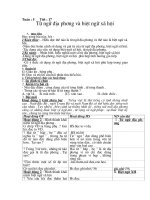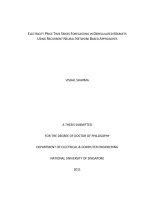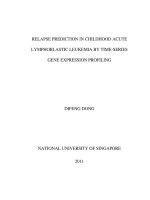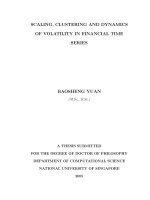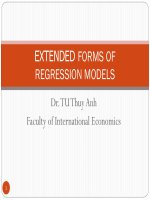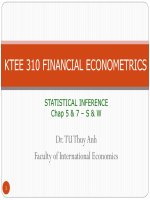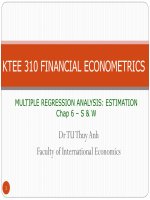Econometrics – lecture 8 – time series
Bạn đang xem bản rút gọn của tài liệu. Xem và tải ngay bản đầy đủ của tài liệu tại đây (385.02 KB, 24 trang )
KTEE 310-FINANCIAL ECONOMETRICS
Lecture 6: TIME SERIES ANALYSIS AND
APPLICATIONS IN FINANCE
Dr TU Thuy Anh
Faculty of International Economics
1
QUARTERLY GDP
160000
140000
120000
100000
80000
60000
40000
20000
0
1
4
7 10 13 16 19 22 25 28 31 34 37 40 43 46 49 52 55 58 61 64 67 70 73 76
2
COMPONENTS OF A TIME SERIES
Time series: An ordered sequence of values of a variable at equally
spaced time intervals
Such as: vn index, inflation, gdp growth rate, etc.
Components:
Trend
Seasonality
Cycle
Irregular
The 4 components may make up a TS in two ways:
additive model: Xt = Tt + St+Ct+It
multiplicative model: Xt = Tt * St *Ct*It
3
ASSUMPTIONS FOR TIME SERIES MODEL
C.1 The model is linear in parameters and correctly
specified.
Y = b 1 + b2 X 2 + … + b k X k + u
C.2 The time series for the regressors are weakly
persistent
C.3 There does not exist an exact linear relationship
among the regressors
C.4 The disturbance term has zero expectation
C.5 The disturbance term is homoscedastic
1
ASSUMPTIONS FOR TIME SERIES MODEL
C.6 The values of the disturbance term have
independent distributions
ut is distributed independently of ut' for t' ≠ t
C.7 The disturbance term is distributed independently
of the regressors
ut is distributed independently of Xjt' for all t'
(including t) and j
C.8 The disturbance term has a normal distribution
Assumption C.6 is rarely an issue with cross-sectional data. When
observations are generated randomly, there is no reason to suppose that
there should be any connection between the value of the disturbance term in
one observation and its value in any other.
AUTOCORRELATION
Y
1
X
In the graph above, it is clear that disturbance terms are not generated
independently of each other. Positive values tend to be followed by positive
ones, and negative values by negative ones. Successive values tend to have
the same sign. This is described as positive autocorrelation.
AUTOCORRELATION
Y
1
In this graph, positive values tend to be followed by negative ones, and
negative values by positive ones. This is an example of negative
autocorrelation.
X
AUTOCORRELATION
Yt b 1 b 2 X t ut
First-order autoregressive autocorrelation: AR(1)
ut rut 1 e t
Fifth-order autoregressive autocorrelation: AR(5)
ut r 1 ut 1 r 2 ut 2 r 3 ut 3 r 4 ut 4 r 5 ut 5 e t
A particularly common type of autocorrelation is first-order autoregressive
autocorrelation, usually denoted AR(1) autocorrelation.
It is autoregressive, because ut depends on lagged values of itself, and firstorder, because it depends only on its previous value. ut also depends on et,
an injection of fresh randomness at time t, often described as the innovation
at time t.
Fifth-order autocorrelation AR(5): it depends on lagged values of ut up to the
fifth lag
AUTOCORRELATION
Yt b 1 b 2 X t ut
First-order autoregressive autocorrelation: AR(1)
ut rut 1 e t
Fifth-order autoregressive autocorrelation: AR(5)
ut r 1 ut 1 r 2 ut 2 r 3 ut 3 r 4 ut 4 r 5 ut 5 e t
Third-order moving average autocorrelation: MA(3)
ut 0e t 1e t 1 2e t 2 3e t 3
Moving average autocorrelation: the disturbance term is a linear combination of
the current innovation and a finite number of previous ones.
MA(3): it depends on the three previous innovations as well as the current one.
AUTOCORRELATION
3
2
1
0
1
-1
-2
-3
ut rut 1 e t
The rest of this sequence gives examples of the patterns that are generated
when the disturbance term is subject to AR(1) autocorrelation. The object is
to provide some bench-mark images to help you assess plots of residuals in
time series regressions.
AUTOCORRELATION
3
2
1
0
1
-1
-2
-3
ut 0.0ut 1 e t
We have started with r equal to 0, so there is no autocorrelation. We will
increase r progressively in steps of 0.1.
AUTOCORRELATION
3
2
1
0
1
-1
-2
-3
ut 0.1ut 1 e t
AUTOCORRELATION
3
2
1
0
1
-1
-2
-3
ut 0.2ut 1 e t
AUTOCORRELATION
3
2
1
0
1
-1
-2
-3
ut 0.3ut 1 e t
With r equal to 0.3, a pattern of positive autocorrelation is beginning to be
apparent.
AUTOCORRELATION
3
2
1
0
1
-1
-2
-3
ut 0.4ut 1 e t
AUTOCORRELATION
3
2
1
0
1
-1
-2
-3
ut 0.5ut 1 e t
AUTOCORRELATION
3
2
1
0
1
-1
-2
-3
ut 0.6ut 1 e t
With r equal to 0.6, it is obvious that u is subject to positive autocorrelation.
Positive values tend to be followed by positive ones and negative values by
negative ones.
AUTOCORRELATION
3
2
1
0
1
-1
-2
-3
ut 0.7 ut 1 e t
AUTOCORRELATION
3
2
1
0
1
-1
-2
-3
ut 0.8ut 1 e t
AUTOCORRELATION
3
2
1
0
1
-1
-2
-3
ut 0.9ut 1 e t
With r equal to 0.9, the sequences of values with the same sign have become
long and the tendency to return to 0 has become weak.
AUTOCORRELATION
3
2
1
0
1
-1
-2
-3
ut 0.95ut 1 e t
The process is now approaching what is known as a random walk, where r is
equal to 1 and the process becomes nonstationary. The terms random walk
and nonstationarity will be defined in the next chapter. For the time being
we will assume | r | < 1.
STATIONARY PROCESSES
Xt is stationary if E(Xt), s X2 t , and the population
covariance of Xt and Xt+s are independent of t
X t b 2 X t 1 e t
1 b2 1
E ( X t ) b 2t X 0 0
s
2
Xt
1 b 22 t 2
1
2
s
s
e
e
1 b 22
1 b 22
population covariance of X t and X t s
b 2s
2
s
e
1 b 22
A time series Xt is said to be stationary if its expected value and population
variance are independent of time and if the population covariance between
its values at time t and time t + s depends on s but not on t.
An example of a stationary time series is an AR(1) process Xt = b2Xt–1 + et,
provided that –1 < b2 < 1, where et is a random variable with 0 mean and
constant variance and not subject to autocorrelation.
NONSTATIONARY PROCESSES
Random walk
X t X t 1 e t
X t X 0 e 1 ... e t 1 e t
E ( X t ) X 0 E (e 1 ) ... E (e n ) X 0
s X2 population variance of ( X 0 e 1 ... e t 1 e t )
t
population variance of (e 1 ... e t 1 e t )
s e2 ... s e2 s e2
ts e2
The condition –1 < b2 < 1 was crucial for stationarity. If b2 = 1, the series
becomes a nonstationary process known as a random walk, e ~ (0,se)
E(Xt) is independent of t and the first condition for stationarity remains
satisfied. However, the condition that the variance of Xt be independent of
time is not satisfied.
NONSTATIONARY PROCESSES
20
15
10
5
Random walk
0
1
11
21
31
41
51
61
71
81
91
-5
-10
-15
The chart shows a typical random walk. If it were a stationary process, there
would be a tendency for the series to return to 0 periodically. Here there is
no such tendency.
